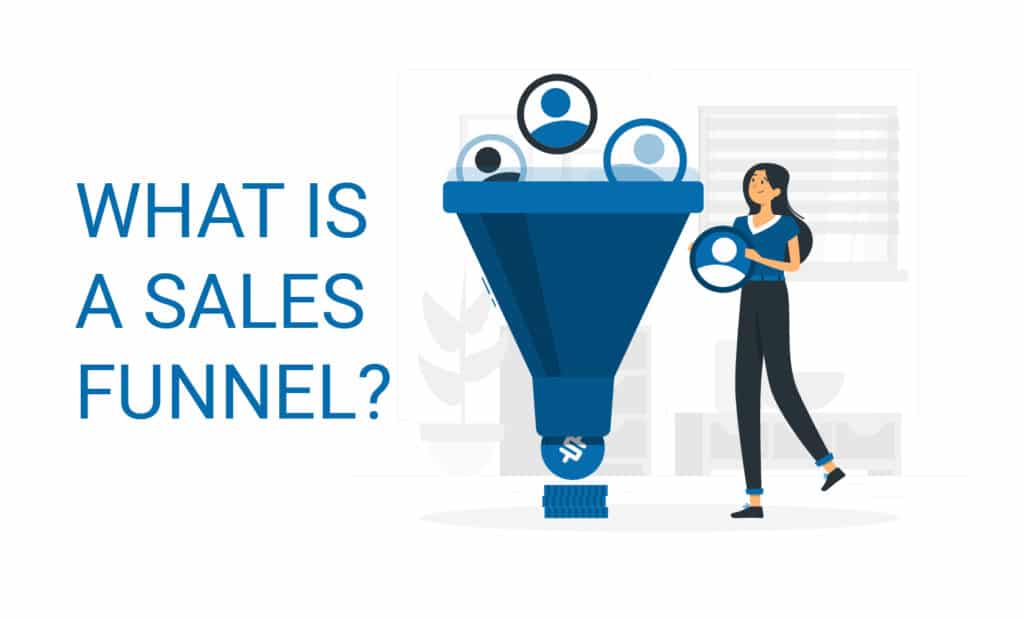A sales funnel is an idea that illustrates the acquisition process, and it’s also a marketing strategy in which professional sales funnel software can automate and improve the whole sales process.
In this article, we will answer what it is and run through all of its stages.
Defining the Sales Funnel
Sales funnel definition and purpose
Sales funnel is a marketing strategy that gathers all potentials at the top with various lead magnet techniques. After first mostly cold contacts are in the top of the funnel, middle of the funnel revolves around building a relationship. Bottom of the funnel is where you make a sale, and your pitch to the potential buyer must be captivating because the deal is still in the air.
Many companies are successful with parts of the funnel, but can’t connect all the dots, and they miss out on deals. The sales funnel has multiple steps, and it needs automation to follow up and complete all the actions, to focus on the right prospects and lead them to the bottom of the funnel.
For sales, persistence is essential, because not all prospects will turn into clients, at least not immediately. It takes time to build a relationship, and sales funnel can help you stay in touch and re-target leads. It may take more than five contacts to warm up a potential customer.
Building a funnel requires a lot of work and multidisciplinary skills. Since the concept of the funnel is dealing with potential customers, a quality CRM solution can help you automate all the stages. In this article, we will go through all the stages of a sales funnel.
1. Top of the Funnel
The purpose of the top of the funnel is to raise awareness and attract as many potential customers as possible. It’s one thing to bring people to your website, and another to make them commit and enter a sales funnel.
Invest in a professional website or landing page for your funnel. You could attract prospects organically with exceptional SEO optimization, with paid digital marketing efforts or traditional sales representative outreach.
Although organic visitors have more chance to jump into your funnel, the funnel itself acts as a great equalizer and should help the marketer to move all potential customers down the pipe.
The valuable content that can attract visitors could be a blog article, free guide, newsletter, or other high-quality material.
To turn visitors into leads, you should seed a lead magnet in the top of the funnel. With your great offer, you’ll have to grab prospects email address, and with signing up to your newsletter, free guide, infographics, videos or another lead magnet, a potential customer becomes a lead.
In the first stage of the sales funnel, you should contact customers with cold mail without attempts to make a sale, and in the second stage, you should start building a relationship with the leads.
2. Middle of the Funnel
Once you have prospects email, it’s time to warm up the contact, but it’s still not the time to sell. It’s crucial to understand that people don’t give their email lightly, and the middle of the funnel tactics should respect that. Communication and consistency are two essential things to follow when dealing with leads.
You should introduce your company to the prospects, give them relatable content of some value. This approach will let the interested party know more about your service/product and why is it beneficial to use what you are offering.
The ways you can hook prospects and keep them warm ranges from a free tutorial, e-book, video, or in-depth guide. The content must be free, valuable, and preferably entertaining.
The sales team has to impress potential customers, build a relationship, interact with them. On the flip side, it’s pivotal to detect serious leads and focus your efforts on quality prospects. Modern CRM solutions can help you assess leads based on properties relevant to your field.
3. Bottom of the Funnel
You have led potential customers from broad inquiry down into the funnel, gave them quality content, and maintained communication to the bottom of the funnel. The last stage is where you make the sales pitch or offer.
Your prospects received freebies, information about the product, and are in communication with your company. At this point of decision for buyer, you want to stay engaged and include a call to action.
To further draw and convert interested leads at the bottom of the funnel and make them into a customer you could offer demo, in-depth side to side competitive feature comparison, product features video, FAQ pages, webinars, testimonials, reviews, lead them to the sales page or send an email with a sales pitch.
It’s important to offer valuable content at the bottom of the funnel to solidify your funnel tactics. In the sales world, whatever you do, there is a chance buyer won’t commit. To reduce unwanted outcome, you have to nurture leads, contact them regularly, and answer their questions.
Sales funnel software can help you automate many tasks that would otherwise be hard to track and execute. It takes a combined effort on multiple platforms. Besides mails, and or calls from the sales team, you might need re-targeting through Google and Facebook.
If you do everything from the top to the bottom of sales funnel, you can still lose some promising leads. That leads us to the improving funnel step.
Find Cracks in Your Sales Funnel and Take Action
Losing a great lead is sales team biggest nightmare. Having a sales funnel software can also help you analyze the behavior of prospects in all stages.
To efficiently detect cracks in your sales funnel, you must have in-depth knowledge about all the steps in the funnel. It sounds straightforward, but not if we know that more than 68% of companies don’t know what their funnel looks like.
Do you truly know what happens at the top? Do you understand how you lead prospects down the funnel, what actions are automated, how your personalized email, landing pages, and other material looks like? A single-stage consists of more activities, so when you search for cracks, you should look into all the substages.
The questions you have to ask are:
- Are the customer getting stuck and where?
- How can I improve the process?
- What information or help are prospects missing?
Take Actions to Fix Cracks in the Sales Funnel
1. Use Google Analytics to track customers
2. Use A/B testing for your content pages
3. Website heatmap can help you position relevant content
4. A will CRM help you take care of your customers the right way
More than 55% of customers said they backed up from buying due to bad communication. Weak personal interaction can cost you losing prospects. Improving customer support could be essential for moving leads through the funnel.
Neglected users will probably go elsewhere. It would be best if you used a sales software/CRM solution to solve those issues. With a quality sales funnel software solution, you can have a better overview of the buyer’s journey through the funnel, and data will help the sales team to respond, re-target and act quickly in case of dropout. A CRM is invaluable to the sales team for all the mentioned features, but mostly to keep track of customers, steps, and timing.




